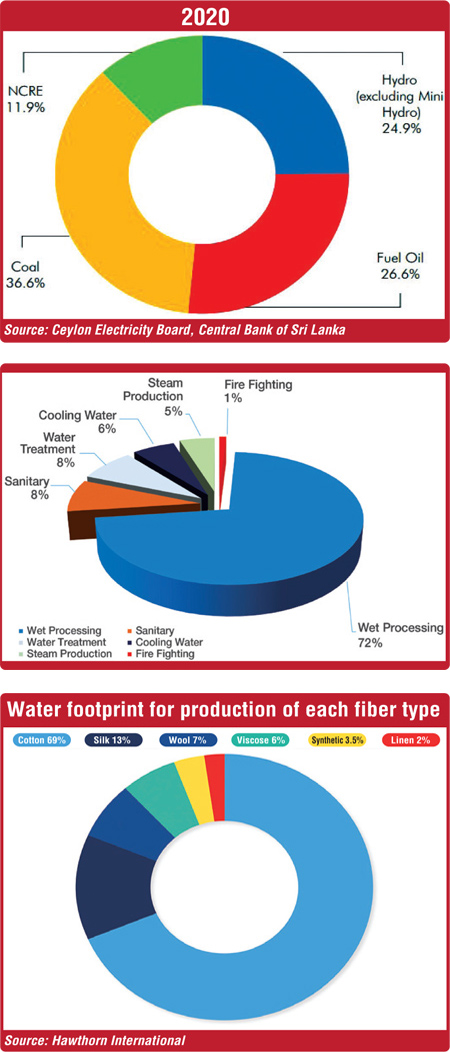Friday Dec 13, 2024
Friday Dec 13, 2024
Thursday, 15 July 2021 00:00 - - {{hitsCtrl.values.hits}}

 The global demand for sustainable and ethical apparel is on the rise. Global brands are increasingly seeking nations and suppliers using environmentally sustainable means of production, using cleaner energy, sustainable water consumption and zero waste practices.
The global demand for sustainable and ethical apparel is on the rise. Global brands are increasingly seeking nations and suppliers using environmentally sustainable means of production, using cleaner energy, sustainable water consumption and zero waste practices.
Products made with dirty power make us less attractive as a manufacturing nation, unable to command premium prices on our exports. The same is true for manufacturers who cannot demonstrate sustainable water use.
Local manufacturers have already proven that greening the business value chain is both economical and profitable. Today, the Sri Lankan apparel sector stands at an inflection point facing the opportunity to reach for cleaner, greener businesses towards achieving competitive advantage.
Declining costs and a national thrust towards renewables
With the introduction of net metering and net accounting, businesses that install rooftop solar and green their energy supply can see an overall cost reduction over the long term.
Although blessed with year around sunshine and rich wind resources, by end of 2020, just over a third (36.8%) of the electricity generated in Sri Lanka came from clean energy sources.
Sri Lanka’s goal of meeting 70% of the energy demand with renewables by 2030 is another positive trend. As a result, large scale investment opportunities are opening up for solar and wind energy parks.
Water consumption in the apparel sector
Water is another critical input for the apparel industry. The wet processing stage is the most water-intensive of all consuming over 70% of the water used.
Case studies from around the world, including China and Bangladesh, show that it’s possible to significantly reduce water consumption by changing the types of processing—continuous, semicontinuous or batch dyeing—and types of dyeing equipment. Reusing water and innovative finishing techniques using laser light and ozone help reduce water consumption.
Using sustainable fabrics that require less water to make is another greening strategy when designing for the environment.
If there is a will, there is a way for greening the apparel sector. Global brands look favourably on countries and manufacturers that are committed to the conservation of natural and water resources.
Protection of water resources is captured under a number of Sustainable Development Goals (SDGs). Beyond these, apparel makers who are serious about safeguarding water resources, reducing consumption and minimising effluents also get bragging rights on improving health, economic and wider environmental benefits.
Building partnerships critical for success
It is necessary to create a broader dialogue and adopt a multi-sector approach to both renewable energy and good water stewardship. ‘The Roadmap Towards a Greener Apparel Sector’ recommends a serious and committed move towards SDG 17, of building partnerships among all stakeholders.
Partnerships must bring together manufacturers, industry associations, service providers, local governments, the Board of Investment, the Export Development Board and local communities. This will help us preserve water resources and flip the apparel sector (and indeed the national) energy mix from dirty to clean.
Sustainable financing for the apparel sector
Garment manufacturers can flip their energy mix from dirty to clean with rooftop solar installations and reap the rewards of competitive advantage. Adopting cleaner production and zero discharge of hazardous chemicals leads to more responsible water consumption. Over the longer term, using product lifecycle assessments and designing for the environment can be achieved with sustainable materials, fabrics and technologies.
Bottlenecks in capital funding can and do get in the way of implementing green projects. Making sustainable financing available would help remove these bottlenecks to greening the Sri Lankan apparel sector.
HSBC and IUCN have been working together to formulate a strategy to build a more resilient apparel industry through adoption of greener practices. “A Road Map Towards a Greener Apparel Sector” report is the result of an extensive research conducted by the project team in partnership with the Joint Apparels Association Forum, Board of Investment Sri Lanka, National Cleaner Production Centre and Sri Lanka Bankers’ Association.
To access the full report visit www.hsbc.lk/ApparelSectorResearch